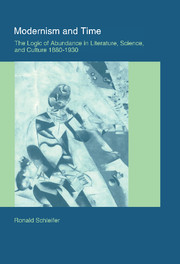Book contents
- Frontmatter
- Contents
- Preface
- Introduction:Post-Englightment Modernism and the experience of time
- PART I POST-ENLIGHTENMENT APPREHENSIONS
- PART II LOGICS OF ABUNDANCE
- 4 The natural history of time: mathematics and meaning in Einstein and Russell
- 5 Analogy and example: Heisenberg, linguist negation, and the language of quantum physics
- 6 The golbal aesthetics of genre: Mikhail Bakhtin and the borders of modernity
- Notes
- References
- Index
4 - The natural history of time: mathematics and meaning in Einstein and Russell
Published online by Cambridge University Press: 22 September 2009
- Frontmatter
- Contents
- Preface
- Introduction:Post-Englightment Modernism and the experience of time
- PART I POST-ENLIGHTENMENT APPREHENSIONS
- PART II LOGICS OF ABUNDANCE
- 4 The natural history of time: mathematics and meaning in Einstein and Russell
- 5 Analogy and example: Heisenberg, linguist negation, and the language of quantum physics
- 6 The golbal aesthetics of genre: Mikhail Bakhtin and the borders of modernity
- Notes
- References
- Index
Summary
If he had smiled, why would he have smiled?
To reflect that each one who enters imagines himself to be the first to enter whereas he is always the last term of a preceding series even if the first term of a succeeding one, each imagining himself to be first, last, only and alone, whereas he is neither first nor last nor only nor alone in a series originating in and repeated to infinity.
James Joyce, Ulysses (1961: 731)In “Development of Concepts in the History of Quantum Mechanics,” Werner Heisenberg discusses the relationship between what he calls “simple mathematical schemes” for quantum mechanics and the elaboration of those schemes discursively. In this chapter, I explore the relationship between mathematical formalism and the semantic concepts that are associated with that formalism, especially in relation to the conception and experience of time. To put it differently, I want to explore the question of whether the mathematical formalism of post-Newtonian physics can be comprehended by a natural history, whether, as Heisenberg says, it can be comprehended by means of a “plain language, understandable to anybody” (1958: 168). A certain kind of formalism, as Stravinsky's observations about the relationship between the “language structure” of art and the “structure” of the phenmenal world (1982: 147) suggest, governs analogical thinking, and both here and in the following chapter I examine this in what I am calling “semantic formalism”.
- Type
- Chapter
- Information
- Modernism and TimeThe Logic of Abundance in Literature, Science, and Culture, 1880–1930, pp. 149 - 183Publisher: Cambridge University PressPrint publication year: 2000



